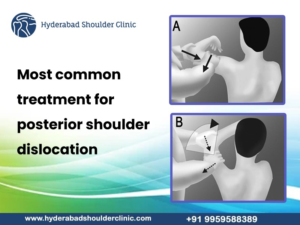The shoulder is particularly prone to dislocation due to its structure and function. It has the greatest range of motion of any joint in the body, which is facilitated by its ball-and-socket design. The shoulder joint is formed where the humerus (upper arm bone) fits into the scapula (shoulder blade) at the glenoid fossa, but the glenoid fossa is relatively shallow. This allows for the extensive mobility of the arm but at the cost of stability.
To compensate for this lack of stability, the shoulder relies on a complex system of muscles, tendons, and ligaments, such as the rotator cuff, to secure the joint. However, these soft tissues can be overextended or torn due to trauma or overuse, leading to dislocation. When a dislocation occurs, the head of the humerus is displaced from the shoulder socket, causing pain and inability to move the arm.
Activities that involve a high risk of falling or sudden impacts, like contact sports or cycling, increase the risk of shoulder dislocation. Additionally, individuals with previous shoulder dislocations or those with loose ligaments (joint hypermobility) are at higher risk for future dislocations due to weakened support structures around the joint.
What is repeated shoulder dislocation?
Repeated shoulder dislocation, also known as recurrent shoulder dislocation, occurs when the shoulder joint dislocates on more than one occasion. After the initial dislocation, the ligaments, tendons, and muscles that support the shoulder may become stretched or torn, making the joint less stable and more susceptible to future dislocations. Each subsequent dislocation can cause further damage to the shoulder’s supportive structures, potentially leading to chronic instability, pain, and a decreased range of motion.
What causes repeated shoulder dislocation?

Factors contributing to repeated shoulder dislocation include:-
- Early mobilisation after dislocation -Not allowing enough time for the shoulder to fully heal after the initial dislocation Returning to high-risk activities too soon
- Inherent joint laxity or looseness.
How can I avoid my shoulder dislocating again?

To prevent your shoulder from dislocating again, it’s important to follow a comprehensive approach that includes strengthening, flexibility, stability exercises, lifestyle modifications, and precautions. Preventative measures, such as physical therapy to strengthen the shoulder muscles and improve joint stability, wearing protective gear during sports, and avoiding movements that put the shoulder at risk, can help reduce the chances of recurrent dislocations.
Here are some strategies to avoid shoulder dislocation again:
- Physical Therapy: Engaging in a physical therapy program tailored to your specific needs can help strengthen the muscles around the shoulder joint, improving stability. Focus on exercises that target the rotator cuff and the scapular stabilisers.
- Gradual Strengthening Exercises: Under the guidance of a healthcare professional, start with low-resistance exercises and gradually increase the intensity. This can help build muscle strength without putting excessive strain on the shoulder.
- Improve Flexibility: Incorporate stretching exercises into your routine to maintain a good range of motion in your shoulder. Be careful not to overstretch, as this can lead to instability.
- Practice Good Posture: Maintaining good posture can help reduce strain on your shoulder muscles and ligaments. Be mindful of your posture while sitting, standing, and during activities.
- Avoid High-Risk Activities: Initially, avoid activities that put your shoulder at risk of dislocating again, such as contact sports, lifting heavy objects above your head, Bowling position of shoulder.Gradually reintroduce these activities as your strength and stability improve.
- Use Protective Gear: If you’re involved in sports or activities that increase the risk of shoulder dislocation, consider using shoulder braces or supports designed to prevent dislocation.
- Warm-Up Properly: Before engaging in physical activity, ensure you warm up your shoulder muscles properly to reduce the risk of injury.
- Listen to Your Body: Pay attention to signs of fatigue or discomfort in your shoulder. Overworking the joint can increase the risk of another dislocation.
- Consult with Healthcare Professionals: Regular follow-ups with your doctor or physical therapist can help monitor your progress and adjust your rehabilitation plan as necessary.
Recurrent shoulder dislocation more than 1 episode requires evaluation by a shoulder specialist, to avoid further shoulder damage with next shoulder dislocation episode.
By adhering to these guidelines and working closely with healthcare professionals, you can significantly reduce the risk of experiencing another shoulder dislocation.
Treatment for repeated shoulder dislocation

For repeated shoulder dislocations, treatment options include:-
- Physical therapy to strengthen the shoulder muscles
- Activity modification
- NSAIDs for pain management
- Immobilization
- Closed reduction
- Surgical interventions like Bankart repair, capsular shift, Latarjet procedure, and rotator cuff repair.
Choosing the right treatment should be based on a thorough evaluation by a healthcare professional to restore function and prevent future dislocations.
A word from Hyderabad shoulder clinics on how can you avoid shoulder dislocating again
For patients who experience repeated shoulder dislocations, it’s crucial to take proactive steps to manage and ideally prevent future occurrences. Understanding the mechanics of your shoulder joint and the factors that contribute to dislocations can help you make informed decisions about your activities and treatments. Remember, managing repeated shoulder dislocations is very important and requires shoulder specialist advice as each episode of dislocation will add some damage to the shoulder joint cartilage. It may require intervention and guided physiotherapy exercises, being cautious with activities, and possibly making lifestyle adjustments to prevent future incidents. Following the advice of healthcare professionals and staying diligent with preventive measures are key. For more information, please visit our website https://hyderabadshoulderclinic.com/ or contact us at +91 9959588389 or shoulderandsportsclinic@gmail.com.





